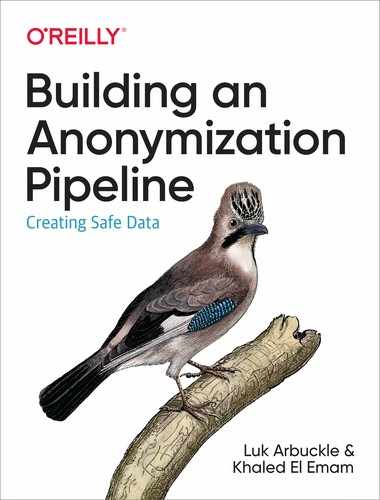Preface
The sharing of data for the purposes of data analysis and research can have many benefits. At the same time, concerns and controversies about data ownership and data privacy elicit significant debate. O’Reilly’s Data Newsletter on Jan 2, 2019, even recognized tools for secure and privacy-preserving analytics as a trend on the O’Reilly radar. Thus an idea was born: write a book that provides strategic opportunities to leverage the spectrum of identifiability to disassociate the personal from data in a variety of contexts to enhance privacy while providing useful data. The result is this book, in which we explore end to end solutions to reduce identifiability of data based on various data collection models and use cases that are enabled by real business needs, learned from working in some of the most demanding data environments and based on practical approaches that have stood the test of time.
Audience
When conceptualizing this book, we divided the audience in two groups: those that need strategic support (our primary audience) and those that need to understand strategic decisions (our secondary audience). Be it government or industry, there are functional needs to deliver on the promise of data. We assume that our audience is ready to do great things, beyond compliance with data privacy and data protection laws.
Primary audience (concerned with crafting a vision, and ensuring the successful execution of that vision):
-
Executive team concerned with how to make the most of data, e.g., to improve efficiencies, derive new insights, and bring new products to market, all in an effort to make their services broader and better while enhancing the privacy of data subjects. They are more likely to skim this book to nail down their vision and how anonymization fits in.
-
Data architects and data engineers that need to match their problems to privacy solutions, thereby enabling secure and privacy-preserving analytics. They are more likely to hone in on specific details and considerations to help support stratetic decisions and figure out the specifics they need for their use cases.
Secondary audience (concerned with understanding the vision and how it will be executed):
-
Data analysts and data scientists who want to understand decisions made regarding the access they have to data. As a detailed-oriented group, they may have more questions than we can cover in one book! From our experience this may lead to interest in understanding privacy more broadly (certainly a good thing).
-
Privacy professionals who wish to support the analytic function of an organization. They live and breath privacy, and unless they have a technical background they may actually want to dig into specific sections and considerations. That way they can figure out how they can support use cases with their strong knowledge and understanding of privacy.
Conventions Used in This Book
The following typographical conventions are used in this book:
- Italic
-
Indicates new terms, URLs, email addresses, filenames, and file extensions.
Constant width-
Used for program listings, as well as within paragraphs to refer to program elements such as variable or function names, databases, data types, environment variables, statements, and keywords.
Constant width bold-
Shows commands or other text that should be typed literally by the user.
Constant width italic-
Shows text that should be replaced with user-supplied values or by values determined by context.
Tip
This element signifies a tip or suggestion.
Note
This element signifies a general note.
Warning
This element indicates a warning or caution.
Using Code Examples
If you have a technical question or a problem using the code examples, please send email to [email protected].
This book is here to help you get your job done. In general, if example code is offered with this book, you may use it in your programs and documentation. You do not need to contact us for permission unless you’re reproducing a significant portion of the code. For example, writing a program that uses several chunks of code from this book does not require permission. Selling or distributing examples from O’Reilly books does require permission. Answering a question by citing this book and quoting example code does not require permission. Incorporating a significant amount of example code from this book into your product’s documentation does require permission.
We appreciate, but generally do not require, attribution. An attribution usually includes the title, author, publisher, and ISBN. For example: “Building an Anonymization Pipeline by Khaled El Emam and Luk Arbuckle (O’Reilly). Copyright 2020 K Sharp Technology Inc. and Luk Arbuckle, 978-1-492-05343-9.”
If you feel your use of code examples falls outside fair use or the permission given above, feel free to contact us at [email protected].
O’Reilly Online Learning
Note
For more than 40 years, O’Reilly Media has provided technology and business training, knowledge, and insight to help companies succeed.
Our unique network of experts and innovators share their knowledge and expertise through books, articles, conferences, and our online learning platform. O’Reilly’s online learning platform gives you on-demand access to live training courses, in-depth learning paths, interactive coding environments, and a vast collection of text and video from O’Reilly and 200+ other publishers. For more information, please visit http://oreilly.com.
How to Contact Us
Please address comments and questions concerning this book to the publisher:
- O’Reilly Media, Inc.
- 1005 Gravenstein Highway North
- Sebastopol, CA 95472
- 800-998-9938 (in the United States or Canada)
- 707-829-0515 (international or local)
- 707-829-0104 (fax)
Email [email protected] to comment or ask technical questions about this book.
For more information about our books, courses, conferences, and news, see our website at http://www.oreilly.com.
Find us on Facebook: http://facebook.com/oreilly
Follow us on Twitter: http://twitter.com/oreillymedia
Watch us on YouTube: http://www.youtube.com/oreillymedia
Acknowledgments
We will gush about our reviewers in this section!
